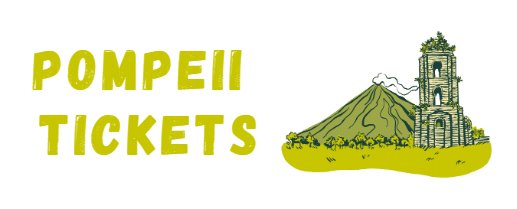About Herculaneum Ruins
Things to Do at the Herculaneum Ruins
One of the notable attractions at the Herculaneum ruins is the Men's Baths, or Thermae, which were public baths where the ancient Romans would gather for leisure and socializing. These baths were an important part of daily life in ancient Rome, and exploring the well-preserved remains of the Men's Baths provides insight into the sophisticated bathing practices of the time.
Must Read: Pompeii Entrances
The House of Neptune and Amphitrite is another fascinating attraction at the Herculaneum ruins. This well-preserved house is known for its stunning frescoes depicting scenes from Greek mythology, including the sea god Neptune and his wife Amphitrite. The intricate details and vivid colours of the frescoes are a testament to the artistic and aesthetic sensibilities of the ancient Romans.
Checkout & Book: Pompeii, Amalfi Coast, and Positano Day Trip from Rome
The Villa of the Papyri is a must-visit attraction at the Herculaneum ruins. This luxurious villa is believed to have belonged to a wealthy Roman family and is known for its magnificent gardens, statues, and large collection of papyrus scrolls. The villa offers a glimpse into the opulent lifestyle of the Roman elite and provides insights into their cultural and intellectual pursuits.
Also Checkout: Pompeii Antiquarium
The Fornici, or archways, are another interesting feature of the Herculaneum ruins. These archways were used as entrances to the city and provided a unique perspective on ancient Roman architecture and urban planning.
Recommended Reads: Pompeii History
The House of the Deer is renowned for its exquisite mosaics and wall paintings. The intricate details and artistic finesse of these mosaics depict various scenes from daily life, mythology, and nature, showcasing the skills of the ancient Roman craftsmen.
The House of the Relief of Telephus is another noteworthy attraction at the Herculaneum ruins. This house is known for its beautifully preserved relief depicting the mythical figure of Telephus, and it offers insights into the Roman fascination with mythology and artistic expressions.
You May Also Like: Things to Do in Pompeii
The Samnite House is another intriguing site at the Herculaneum ruins. This house is known for its well-preserved architectural features, including the atrium, peristyle, and frescoes, providing a glimpse into the ancient Romans' daily life and living spaces.
Also Read: Best Time to Visit Pompeii
The Hall of the Augustals is a unique attraction at the Herculaneum ruins. This hall was dedicated to the imperial cult and served as a gathering place for the Augustals, a religious association that honoured the Roman emperor. The hall offers insights into the religious practices and beliefs of the ancient Romans.
Also Checkout: What to See in Pompeii
The House of the Black Room/Salon, also known as Casa del Salone Nero, is famous for its unique black-and-white frescoes depicting intricate designs and patterns. This house offers a glimpse into the artistic and aesthetic tastes of the ancient Romans and provides an intriguing contrast to the colourful frescoes found in other houses.
Recommended Reads: Naples to Pompeii Day Trip
The House of the Beautiful Courtyard, or Casa del Bel Cortile, is known for its stunning courtyard with a central pool surrounded by decorative elements and frescoes. This house showcases the Roman appreciation for beauty and aesthetics and offers a serene and picturesque spot to explore.
Must Read: Pompeii Guided Tour
Book Pompeii Tickets
FAQs
Are kids allowed to the Herculaneum ruins?
Yes, kids are allowed to visit the Herculaneum ruins. However, it is important to note that the site involves a considerable amount of walking and may not be suitable for very young children or those with mobility issues. It is advisable to assess the interests and abilities of your kids before planning a visit and ensure they are supervised at all times during the visit.
Must Read: Naples to Pompeii Trip
Is Herculaneum better or Pompeii?
Whether Herculaneum or Pompeii is better depends on personal preferences. Both sites are significant archaeological sites that were buried by the eruption of Mount Vesuvius in 79 AD and offer insights into ancient Roman life. However, Herculaneum is smaller and better preserved compared to Pompeii, with more intact buildings, mosaics, and frescoes. It provides a more intimate and immersive experience, while Pompeii is larger and offers a broader scope of ruins to explore. It ultimately depends on individual interests and priorities.
Must Read: Pompeii Forum
Are kids allowed to the Herculaneum ruins?
Yes, kids are allowed to visit the Herculaneum ruins. However, it is important to ensure that they are supervised at all times and follow the rules and regulations of the site. As the ruins involve a considerable amount of walking and may require some historical context to fully appreciate, it is advisable to assess the interests and abilities of your kids before planning a visit.
What is Herculaneum famous for?
Herculaneum is famous for being an ancient Roman city that was buried by the volcanic eruption of Mount Vesuvius in 79 AD, along with Pompeii and other nearby settlements. The ruins of Herculaneum are famous for their remarkable state of preservation, which offers insights into the daily life, architecture, art, and culture of the ancient Romans. The well-preserved ruins, mosaics, frescoes, and artifacts found at Herculaneum are a significant archaeological treasure, attracting visitors from around the world who are interested in history, archaeology, and ancient Roman civilization.
Must Checkout - Vatican Library

